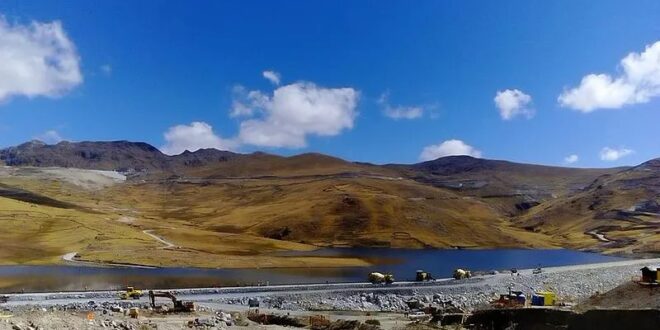The world’s historic pivot toward curbing carbon emissions is likely to spur unprecedented demand for some of the most crucial metals used to generate and store renewable energy in a net-zero emissions by 2050 scenario.
A resulting surge in prices for materials such as cobalt and nickel would bring boom times to some economies that are the biggest exporters—but soaring costs could last through the end of this decade and could derail or delay the energy transition itself.
Prices for industrial metals, an important foundation for the global economy, have already seen a major post-pandemic rally as economies re-opened, as we recently wrote. Our latest research, included in the October World Economic Outlook and a new IMF staff paper, details the likely effects of the energy transition for metals markets and the economic impact for producers and importers.
For example, lithium, used in batteries for electric vehicles, could rise from its 2020 level around $6,000 a metric ton to about $15,000 late this decade—and stay elevated through most of the 2030s. Cobalt and nickel prices would also see similar surges in coming years.
Net-zero scenario
We look specifically at the goal of limiting global temperature increases to 1.5 degrees Celsius, which requires a transformation of the energy system that could substantially raise metals demand as low-emission technologies—including renewable energy, electric vehicles, hydrogen, and carbon capture—require more metals than fossil-fuel counterparts.
Our focus is on four important metals among the variety being used for the transition. They are copper and nickel, major established metals that have traded on exchanges for decades, and minor-but-rising lithium and cobalt, which have traded on exchanges only recently but are gaining popularity because they are important for the energy transition.
The fast pace of change needed to meet climate goals, such as the International Energy Agency’s (IEA) Net Zero by 2050 Roadmap, implies soaring metals demand in the next decade. Under the roadmap’s ambitious scenario, lithium and cobalt consumption jumps more than sixfold to satisfy needs for batteries and other clean energy uses. Copper use would double and nickel’s would quadruple, though this includes meeting needs unrelated to clean energy.
Metal prices

While metals demand could soar, supply typically reacts slowly to pricing signals, partly depending on production. Copper, nickel, and cobalt come from mines, which require intensive investment and take on average more than a decade from discovery to production according to the IEA. In contrast, lithium often is extracted from mineral springs and brine via salty water pumped from below ground. That shortens lead times for new production to average roughly five years. Supply trends also are influenced by extraction technology innovation, market concentration, and environmental regulations. The combination of soaring demand and slower supply changes can spur prices to climb. In fact, if mining had to satisfy consumption under the IEA’s net-zero scenario, our recent analysis shows prices could reach historical peaks for an unprecedented length of time—and those higher costs could even delay the energy transition itself.
Specifically, cobalt, lithium, and nickel prices would rise several hundred percent from 2020 levels and peak around 2030. However, copper is less of a bottleneck as its demand increases are not as steep. We estimate prices would peak as in 2011, though be elevated for longer.
The demand surge under a net-zero scenario is frontloaded because renewable energy components such as wind turbines or batteries need metals upfront. On the supply side, however, production is slow to react due to the long lead times for opening mines, and only eventually eases market tightness after 2030.
Macro-relevancy
Under a net-zero emissions scenario, booming demand for the four energy transition metals alone would boost their production value sixfold to $12.9 trillion over two decades. This could rival the roughly estimated value of oil production in a net-zero scenario over that period. The four metals could affect the economy via inflation, trade and output, and provide significant windfalls to commodity producers.
The concentrated supply of metals implies some top producers may benefit. Usually, countries with the largest output have the greatest reserves, and likely would be major prospective producers. The Democratic Republic of the Congo, for example, accounts for about 70 percent of global cobalt output and half of reserves. Other standouts include Australia, for its lithium, cobalt, and nickel; Chile, for copper and lithium; along with Peru, Russia, Indonesia and South Africa.
A long-lasting metals boom could also bring substantial economic gains, especially for large exporters. In fact, we estimate that a persistent 10 percent rise in the IMF metal price index adds an extra two-thirds of a percentage point to the pace of economic growth experienced by metals exporting countries relative to importing ones. Exporters also would see a similar magnitude of improvement for government fiscal balances from royalties or tax revenues.
Policy implications
The high uncertainty surrounding demand scenarios is an important caveat. Technological change is hard to predict, and the speed and direction of the energy transition depends on the evolution of policy decisions. Such ambiguity is detrimental because it may hinder mining investment and raise the odds that high metal prices derail or delay the energy transition.
A credible, globally coordinated climate policy; high environmental, social, labor, and governance standards; and reduced trade barriers and export restrictions would allow markets to operate efficiently. This would direct investment to sufficiently expand metal supply, avoiding unnecessarily cost increases for low-carbon technologies and aiding the clean energy transition.
Finally, an international body with a mandate covering metals—analogous to the IEA for energy or the UN Food and Agriculture Organization—could play a key role in data dissemination and analysis, setting industry standards, and fostering global cooperation.
 Eurasia Press & News
Eurasia Press & News



